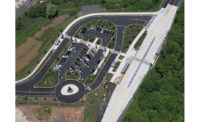Best Airports/Transit Project








The first launch pad in the U.S. to be built specifically as a multi-user facility to accommodate rockets from private companies, the Mid-Atlantic Regional Spaceport Pad-0A in Wallops Island, Va., enables continued space exploration and aims to foster the development of the commercial space transportation industry.
Located at the Mid-Atlantic Regional Spaceport on a narrow Virginia barrier island, the project created the most compact launch site ever designed for a medium-class, liquid-fueled launch vehicle, project officials say. Commodity tanks, a water tower and a deluge water-retention pond had to be located closer to the pad than usual, heightening safety concerns over anticipated launch loads. To address the issue, the team added blast-protection structures and hardened the buildings.
For decades, launch pads have used the same type of refractory concrete to protect the flame deflector and adjacent structures. On this project, however, the team selected materials—Sentinel RC and HP Cast 93Z, developed by Harbison-Walker—that provided the required protection while reducing costs.
The limited site area also required an innovative approach to the facility's lightning protection system. While other launch facilities use a standard guy-wire-and-tower system, the Pad-0A team designed a more compact system using steel poles that usually are used to support lights at highway interchanges. This tactic required further coordination with the pole manufacturer as well as testing to ensure the poles were strong enough to withstand blast loads. The solution significantly trimmed construction costs and saved time.
Since the site was located less than 25 ft from the seawall—closer than any other launch facility—the team had to raise the floor elevation to prevent flooding.
Faced with a fast-track schedule, the design team needed to release incremental design packages so the contractors could start building facilities. In addition, both the pad and its first launch vehicle were being designed at the same time, requiring collaboration between those teams.
During construction, the site was hit by heavy storms, including Superstorm Sandy. The storms caused severe flooding, but the site remained undamaged, partly because of precautions taken by the contractors.
All contractors attended NASA's Wallops Flight Facility Safety Training and Mid-Atlantic Regional Spaceport's Specific Facility Safety Training classes. Each contractor also submitted a weekly contractor-specific safety plan, along with pertinent operation status information. Open communication allowed team members to provide input on best practices for safety, quality and production as conditions changed.
For the bridge deck that approaches the launch pad, the team developed an approved design to clamp specially made brackets around the piles using clevis hooks to attach retractable tools. The solution was load-tested above Occupational Safety & Health Administration requirements and, ultimately, enabled workers to move freely about the deck without the risk of falls.
The project recorded no lost-time incidents and had an OSHA recordable incident rate of zero.
Mid-Atlantic Regional Spaceport Pad-0A. Wallops Island, Va.
Key Players
Owner Virginia Commercial Space Flight Authority
Design Firm Reynolds, Smith & Hills
General Contractor Baker Concrete
Structural Engineer Reynolds, Smith & Hills
Civil Engineer Reynolds, Smith & Hills
MEP Engineer Reynolds, Smith & Hills
Electrical Engineer Reynolds, Smith & Hills







